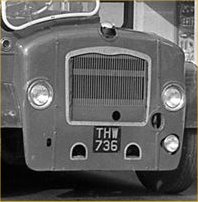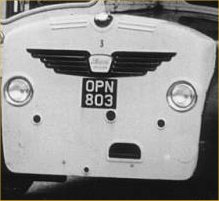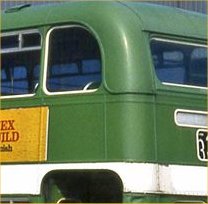 |
WORK IN PROGRESS This page is currently incomplete and will be updated to include historical information - if you can help with additions, corrections or photos please do get in touch |
 |
WORK IN PROGRESS This page is currently incomplete and will be updated to include historical information - if you can help with additions, corrections or photos please do get in touch |
Last Updated : September 24th 2019 (under construction)
| Chassis Number The chassis number of a Bristol Lodekka can normally be found in two places on the vehicle. The most reliable identifier is the six-digit number stamped at the front of the nearside dumn iron next to the engine - pop open the bonnet, look down and you should be able to see it. The other place is the body builder's plate which is usually located at the foot of the staircase but can sometimes be missing if it has been removed during the life of the bus. This plate also displays the Eastern Coach Works body number which should of course always make a pair with the chassis number. There were several designs during the production run, some of which are shown below.    
|
| Ventilator Layout All Sliders Bristol Omnibus employed a ventilator layout consisting of sliders to all opening windows on both decks   |
| Driver's Window/Beading Pre-Production LD On the six 1953 pre-production LD6Bs, the driver's window was curved as on early production LDs, but the beading beneath was straight as on the KSW.  Early LD Subsequent production examples had both curved window and curved beading  Later LD Later in the production run (which sanction did this begin?) the profile was redesigned with a straight upper edge rising towards the front of the vehicle and a square cab door window edged once again with straight beading:  Flat-Front Lodekkas With the introduction of the flat-floor models from 1960 the whole profile was redesigned once again, this time with straight upper and lower edges to the windows both rising towards the front of the vehicle:  |
| Radiator Grille Style PHW958 The six pre-production Lodekkas were delivered with long radiators with a grille that had 24 slots arranged in two rows of 12  Long Apron Other early LDs were also delivered with long radiator grilles of an updated pattern. Many were replaed with shorter versions during their operational life (such as THW736 - see below), but some did last through to withdrawal and onto further use/preservation in some cases.   Initial Short Grille The long apron grille was replaced by ECW in 1956 by a shorter design which did not emcompass the registration plate.  Winged Motif Lodekkas that were fitted with Cave-Browne-Cave radiator/heating equipment did not require a traditional radiator behind the front cowl. Consequently ECW experimented with deleting the grille, merely applying the winged motif from the Bristol MW model with some examples in the Brighton & Hove and Crosville fleets. The result was not universally considered aesthetically pleasing and many - if not all - were replaced with conventional grilles during their lives, such as OPN803 illustrated below.   Later Short Grille A final facelift during 1962 saw the grille altered once more, this time the grille was the same as that used on contemporary ECW-bodied RELH coaches but incorporating a Lodekka badge at the bottom as well as the oval ECW badge at the top. The rolled up blind shown in the photo was for blanking off the grille in winter to aid internal vehicle heating (the blind is shown in the summer position while the photo of ODL7 above shows it in the winter position).  |
| Destination Gear Controls Companies took very different approaches to changing the destination blinds on vehicles. Some made it the driver's responsibility and placed the destination gear control handles inside the driver's cab (Bristol Omnibus, United Auto ?others?) while others made the conductor walk outside in all weather round to the front of the bus where the handles could be found. Footholes and a grabrail were added to aid the shorter conductor and these all help in vehicle identification. Early LDs had two steps, one either side of the registration number while later models had a larger single step on the nearside.    |
| Destination Blinds 3-piece front blind  2-piece rear blind  |
| Front Bulkhead Window Large Vent Western SMT specified this large vent in the bulkhead window for its MCS batch only:    |
| Rear Windown Profile The pre-production Lodekkas and very early production LDs had single piece rear windows, the size depending on whether the vehicle was open platform or had a rear door:  By the end of 1954 the shape had been completely reprofiled now consisting of two concave panes of glass each facing inwards:  Where the platform did not extend round to the rear of the vehicle the windows were made wider:  However a few Hants & Dorset LDs with smaller open platforms were built with the narrow windows to allow later rebuilding to include platform doors. The rebuilding did happen as noted here:  The coach versions of Eastern National (and other operators?) had an unusual arrangement at the rear with a single window in the emergency door in the centre of the back of the bus and a very shallow upper deck rear window:  |
| Split-step Platform Floor Some Brighton & Hove vehicles were delivered with a split-step arrangement on the open rear platform as seen here on OPN807 compared to the more usual arrangement on  |
| Metal Strips Another Brighton & Hove variation was this metal strip fitted above the windows on the four central bays on both decks on some of their Lodekkas. Its purpose is unclear but may well have been an attempt to stop water ingress from the windows during a rainstorm.  |
| Upper Deck Extended Rain Strip On some B, C and D-registered FSs ECW factory fitted an extended rear rain strip which swept down from above the rear quadrant window and around the corner to just below the upper deck back window. This was presumably to stop rain water splashing passengers as they boarded and alighted via the platform.  |
| Front Entrance Decency Screen On front-entranced Lodekka models (FSF and FLF) there was a decency screen placed ahead of the forwardmost nearside seats. Early examples, including both prototypes were plain metal which was changed to include a narrow window to provide better forward vision for passengers. It is believed that this was overlooked initially because both prototypes were fitted with sliding doors that were recessed behind that area of bodywork which would have meant there wasn't enough width to the screen to include a window. Both configurations are shown in the picture below taken by Nick Bailey (click on the thumbnail to enlarge).  |